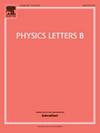Testing neutrino mass hierarchy under type-II seesaw scenario in U(1)X from colliders
IF 4.3
2区 物理与天体物理
Q1 ASTRONOMY & ASTROPHYSICS
引用次数: 0
Abstract
The origin of tiny neutrino mass is a long standing unsolved puzzle of the Standard Model (SM), which allows us to consider scenarios beyond the Standard Model (BSM) in a variety of ways. One of them being a gauge extension of the SM that may be realized as in the form of an anomaly free, general extension of the SM, where an triplet scalar with a charge is introduced to have Dirac Yukawa couplings with the SM lepton doublets. Once the triplet scalar develops a Vacuum Expectation Value (VEV), light neutrinos acquire their tiny Majorana masses. Hence, the decay modes of the triplet scalar have direct connection to the neutrino oscillation data for different neutrino mass hierarchies. After the breaking of the gauge symmetry, a neutral gauge boson acquires mass, which interacts differently with the left and right handed SM fermions. Satisfying the recent LHC bounds on the triplet scalar and boson productions, we study the pair production of the triplet scalar at LHC, 100 TeV proton proton collider FCC, and colliders followed by its decay into dominant dilepton modes whose flavor structure depend on the neutrino mass hierarchy. Generating the SM backgrounds, we study the possible signal significance of four lepton final states from the triplet scalar pair production. We also compare our results with the purely SM gauge mediated triplet scalar pair production followed by four lepton final states, which could be significant only in collider.
来自U(1)X的对撞机在ii型跷跷板场景下测试中微子质量层次
微小中微子质量的起源是标准模型(SM)的一个长期未解之谜,它使我们能够以多种方式考虑超越标准模型(BSM)的方案。其中之一是标准模型的量规扩展,它可以以标准模型的无反常一般 U(1)X 扩展的形式实现,其中引入了一个带 U(1)X 电荷的 SU(2)L 三重标量,它与标准模型的轻子双子具有狄拉克尤卡瓦耦合。一旦三重标量产生了真空期望值(VEV),轻中微子就会获得微小的马约拉纳质量。因此,三重标量的衰变模式与不同中微子质量等级的中微子振荡数据有直接联系。U(1)X规对称性破缺后,一个中性的U(1)X规玻色子(Z′)获得了质量,它与左右手SM费米子的相互作用是不同的。为了满足最近大型强子对撞机对三重标量和 Z′玻色子产生的约束,我们在大型强子对撞机、100 TeV 质子对撞机 FCC、e-e+ 和 μ-μ+ 对撞机上研究了三重标量的成对产生,然后研究了它衰变成主导二轻子模式的情况,其味道结构取决于中微子的质量层次。通过生成 SM 背景,我们研究了三重标量对产生的四种轻子终态的可能信号意义。我们还将我们的结果与纯粹由SM规介导的三重标量对产生后的四重轻子终态进行了比较,后者只有在μ-μ+对撞机中才有意义。
本文章由计算机程序翻译,如有差异,请以英文原文为准。
求助全文
约1分钟内获得全文
求助全文
来源期刊

Physics Letters B
物理-物理:综合
CiteScore
9.10
自引率
6.80%
发文量
647
审稿时长
3 months
期刊介绍:
Physics Letters B ensures the rapid publication of important new results in particle physics, nuclear physics and cosmology. Specialized editors are responsible for contributions in experimental nuclear physics, theoretical nuclear physics, experimental high-energy physics, theoretical high-energy physics, and astrophysics.
 求助内容:
求助内容: 应助结果提醒方式:
应助结果提醒方式:


